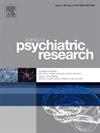Mental health outcomes, associated factors, and coping strategies among LGBTQ adolescent and young adults during the COVID-19 pandemic: A systematic review
IF 3.7
2区 医学
Q1 PSYCHIATRY
引用次数: 0
Abstract
LGBTQ adolescents and young adults have been disproportionately affected by the COVID-19 pandemic. This review aims to describe the impact of the COVID-19 crisis on mental health among LGBTQ adolescents and young adults, identify associated factors, and summarize coping strategies. A systematic review was conducted by searching six databases (PubMed, Embase, PsycINFO, CINAHL, Web of Science, MEDLINE). Eligibility criteria included (1) reported mental health outcomes, (2) conducted among LGBTQ adolescents and young adults, and (3) data collection occurred since January 2020. All studies were screened independently, and relevant data were synthesized following PRISMA guidelines. Of 395 records, 67 articles were screened for eligibility. Among these, 39 studies met the inclusion criteria. LGBTQ adolescents and young adults reported substantial mental health burdens, including depression, anxiety, stress, and loneliness during the pandemic. A pooled prevalence of depressive symptoms with a combined sample size of 7326 LGBTQ adolescents and young adults was 59% (95%CI: 0.48–0.70), (I2 = 98.95%, p < 0.001). Among anxiety outcomes, the pooled prevalence with a sample size of 3258 LGBTQ adolescents and young adults was 55% (95% CI: 0.46–0.63), (I2 = 95.70%, p < 0.001). Individual factors associated with mental distress included age, gender, and history of mental health disorders. Interpersonal and community-level factors included loss of safe spaces, family support, and discrimination on sexual and gender minority identity. Strategies to cope with distress include the use of social media and increased use of alcohol, tobacco, and other drugs. The pandemic has had a substantial negative impact on psychological distress among LGBTQ adolescents and young adults. Results substantiate the need for further research into social media as a coping instrument and the expansion of telehealth mental health services.
2019冠状病毒病大流行期间LGBTQ青少年和年轻人的心理健康结果、相关因素和应对策略:一项系统综述
LGBTQ青少年和年轻人受到COVID-19大流行的影响尤为严重。本综述旨在描述COVID-19危机对LGBTQ青少年和年轻人心理健康的影响,确定相关因素,并总结应对策略。通过检索六个数据库(PubMed, Embase, PsycINFO, CINAHL, Web of Science, MEDLINE)进行系统评价。入选标准包括(1)报告的心理健康结果,(2)在LGBTQ青少年和年轻人中进行的研究,以及(3)数据收集于2020年1月以后。所有的研究都是独立筛选的,相关数据是按照PRISMA指南合成的。在395份记录中,67篇文章被筛选为合格。其中39项研究符合纳入标准。在大流行期间,LGBTQ青少年和年轻人报告了严重的精神健康负担,包括抑郁、焦虑、压力和孤独。7326名LGBTQ青少年和年轻人的抑郁症状总患病率为59% (95%CI: 0.48-0.70), (I2 = 98.95%, p 2 = 95.70%, p
本文章由计算机程序翻译,如有差异,请以英文原文为准。
求助全文
约1分钟内获得全文
求助全文
来源期刊

Journal of psychiatric research
医学-精神病学
CiteScore
7.30
自引率
2.10%
发文量
622
审稿时长
130 days
期刊介绍:
Founded in 1961 to report on the latest work in psychiatry and cognate disciplines, the Journal of Psychiatric Research is dedicated to innovative and timely studies of four important areas of research:
(1) clinical studies of all disciplines relating to psychiatric illness, as well as normal human behaviour, including biochemical, physiological, genetic, environmental, social, psychological and epidemiological factors;
(2) basic studies pertaining to psychiatry in such fields as neuropsychopharmacology, neuroendocrinology, electrophysiology, genetics, experimental psychology and epidemiology;
(3) the growing application of clinical laboratory techniques in psychiatry, including imagery and spectroscopy of the brain, molecular biology and computer sciences;
 求助内容:
求助内容: 应助结果提醒方式:
应助结果提醒方式:


